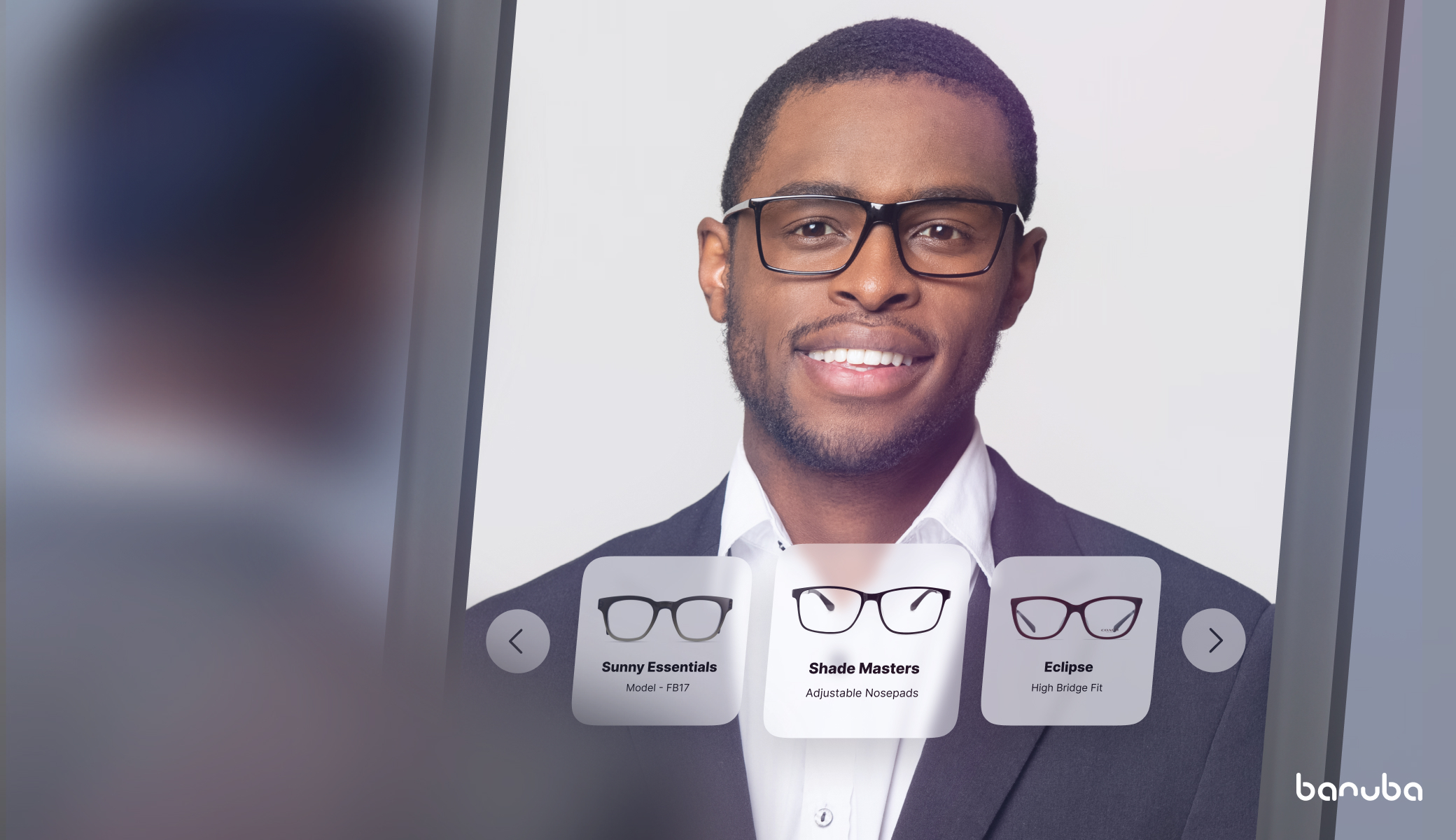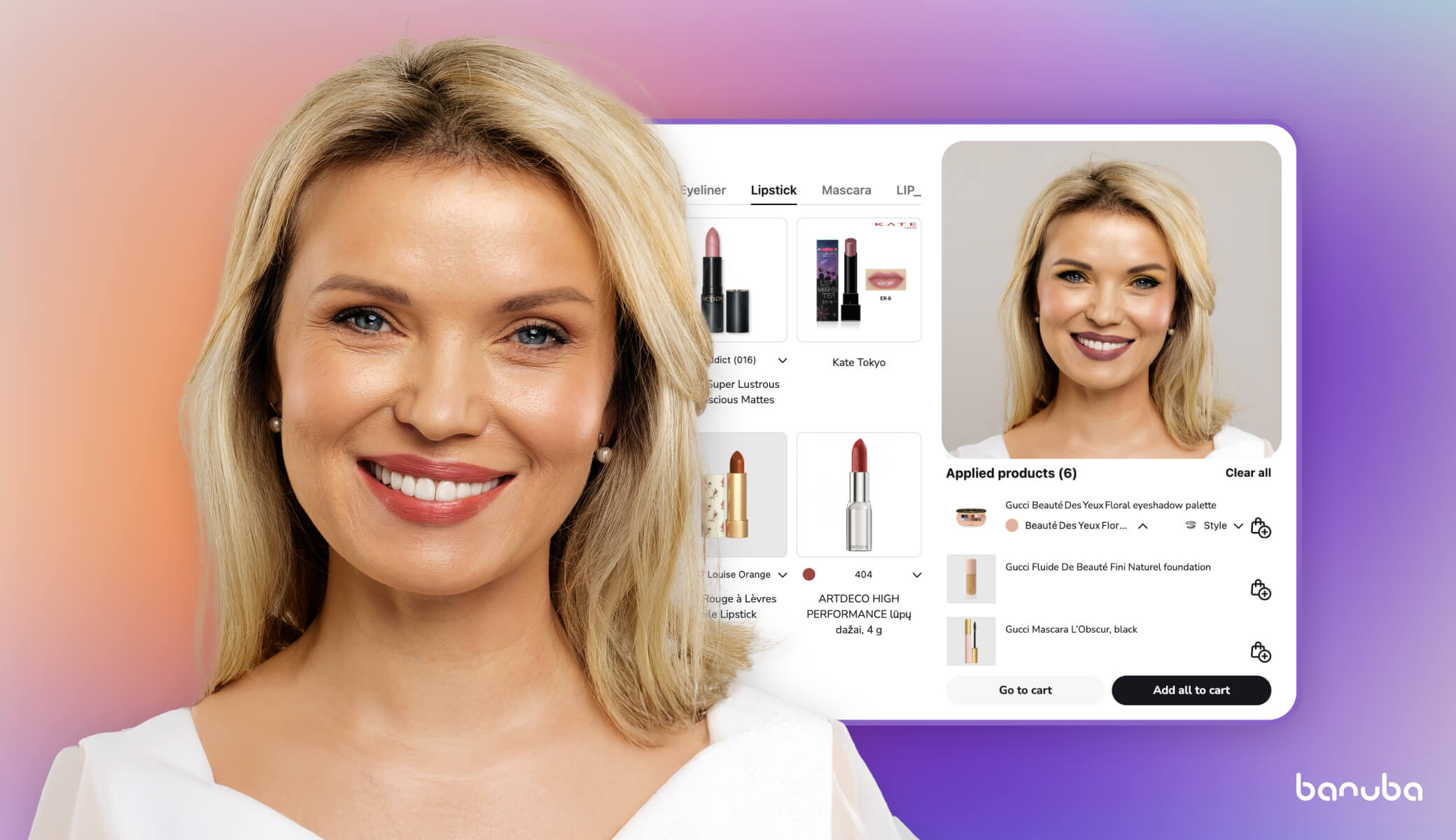[navigation]
What Is An AR Mirror?
Regular mirrors show us what things look like in real life. But AR mirrors take it further by adding digital enhancements on top of that. An augmented reality smart mirror uses a camera and a display or a reflective surface combined with AR software to enable virtual try-on of clothes, shoes, accessories, makeup, glasses, etc. On the one hand, some beauty and fashion items like colored lenses cannot be offered for try-on for sanitary reasons – this is where AR mirrors come to help. On the other hand, fitting items like clothes or glasses via augmented reality makes shopping much more fun and engaging.
There are several ways of building a smart mirror, and we have covered them in our blog before. An AR mirror can be built with as little as a tablet with a decent camera and virtual try-on software. There are also more advanced options like a full-length display that mimics an actual mirror. No matter the hardware, the software for this type of device remains pretty much the same. Mirrors use AR-based try-on software that allow users to envision clothes, jewelry, accessories, makeup, or other items on them without having to actually put them on.
Besides the essentials like face or body tracking and virtual try-on, top software for smart mirrors can boast a wide range of features like:
- Precise face and body segmentation
- Advanced 3D models for try-on that looks indistinguishable from real-life items
- Touchless interface (gesture recognition or voice controls)
- AI product recommendation engine
- Additional face masks and overlays for fun and engagement
The new generation of AR smart mirrors does not only allow users to try on selected items, but also provides entertainment, adding an element of fun into the shopping routine. Let’s take a closer look at some of the most prominent recent cases where AR and smart mirrors proved to make a significant enhancement in offline shopping.

AR in eCommerce today
According to Statista, the AR & VR market is projected to generate revenue of $38.6 bln in 2024. The smart mirror market is a rapidly expanding one, with estimated CAGR for the next five years being approximately 9.5% in the United States.
Augmented reality is becoming common practice in the eyes of shoppers. Approximately two-thirds of people are keen on using AR to assist them while shopping. This statistic suggests that a significant share of consumers are open to the integration of AR into their shopping experience. And major brands all around the world are already leveraging the power of augmented reality to boost engagement and brand recognition.
H&M: Smart Mirrors For Try-On
In 2022, the Swedish fashion retailer H&M introduced an augmented reality addition to their COS stores in the United States. The devices offer personalized styling recommendations along with virtual try-on.
As brand representatives state, “[...] customers expect retail experiences that are smooth, creative and fun while also catering to their individual, unique style. That is why we continue to challenge ourselves and explore new ideas, to create true customer value and drive change”. Therefore, the tendency is clear: customers seek an immersive, entertaining experience combined with utility and convenience.
Besides smart mirrors, H&M also experimented with new checkout solutions and ways to provide enhanced sustainability and decreased return rate – another major feature virtual try-on contributes to.
Coach: #InMyTabby AR Experience
This is perhaps one of the most prominent cases featuring a smart mirror in 2023. The use of the AR technology extends beyond simply trying items on.
Designer handbag brand Coach installed an “AR mirror” on the storefront of its SoHo flagship. As people walk by, the mirror stops them in their tracks with a reflection of them holding various versions of the brand’s best selling bag, the Tabby. The mirror offers four different 3D effects to complete the look, including fairy wings and a signature black ribbon that wraps around the user’s virtual body.
In most cases, AR mirrors are placed inside stores with the task of turning a disinterested customer into a buyer. However, Coach's AR mirror at the storefront has a distinct purpose: grabbing your attention and inviting you to try on products in person (or in front of another AR mirror). Being a powerful attention-getter on its own, this smart mirror seamlessly integrates a promotion into an entertaining experience, resulting in an increase in conversion rate and, consequently, sales.
How AR Smart Mirrors Can Benefit Your Business
Shoppers are naturally hesitant to buy a product without giving it a try. This is especially true for clothing, makeup, and skincare products. As of 2024, the trend for personalized approach and interactive experiences is as relevant as ever. Consumers are now seeking a more interactive and personalized shopping experience, where they can virtually 'try on' products before purchasing.
Virtual mirrors can increase sales by taking an omnichannel approach. The technology not only decreases the time customers spend finding the right product but lets them browse many more items when in the store.
Another benefit of smart mirrors lies in their ability to convert occasional shop visitors into brand advocates. Shopify discovered that products advertised with the use of AR had a 94% higher conversion rate than products promoted without it. A brand that uses a technology of this kind is more memorable than one that doesn’t – therefore users are more likely to consider making a purchase when the feature is present. And cases like Coach not only further prove this point but also showcase how a creative use of smart mirrors can become a breath of fresh air for a brand’s communication.
Besides virtual try-on, an AR mirror can be turned into a user-generated content hub for your store. A selfie taken with a smart mirror, embellished with beautiful 3D overlays or face masks, is fun and attractive enough to post on social media. And when large numbers of users post their augmented portraits with a specific hashtag or brand mention, it is only a matter of time before more people show interest in your product, and new customers appear. This way, AR mirrors combine virtual try-on with photo booth functionality, activating another channel of communication with both potential and actual customers. Check out the AR photo booth solution by Banuba that can be easily integrated into your smart mirror.

Conclusion
AR mirrors have the potential to redefine retail in 2024, seamlessly blending physical and digital realms for an immersive shopping experience. At this point, smart mirrors are more than a trend – they are a strategic tool to meet evolving consumer expectations, capturing attention, driving conversion rates, and boosting sales.
Banuba's AR mirrors go beyond the store, offering an omnichannel approach that saves time and increases product exploration. With advanced features like virtual try-on and AI-driven recommendations, Banuba's solution transforms casual visitors into brand advocates. Check out our offer for augmented reality smart mirrors and virtual try-on here.









